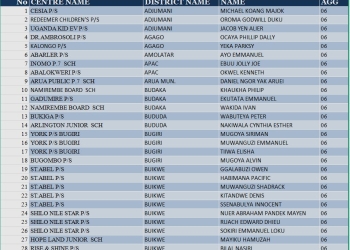
KAMPALA – Looking at Uganda’s annual budget and the amount of money government spends on salaries leave many wondering whether we have any patriotic planners for this country.
By and large, Uganda’s budget process lacks proper planning and prioritization of resources for expenditure.
The government had made it a habit of creating authorities and commissions out of departments which were previously under a ministry.
You can take an example of an engineer at UNRA with the same experience and qualifications but earns 10 times as much as another engineer at the Ministry of works.
For those who may not be in the know, Uganda currently has 134 districts and each district carries with it a burden of a Chief Administrative Officers together with a deputy and Assistant, a Resident District/city Commissioner with a deputy, a District Internal Security Officer with a deputy, a District Police Commander and of course a police station.
This of course calls for the construction of a District headquarters. For those without permanent
office space, the government is spending exorbitantly to maintain their office rent yet they could have been accommodated at the district headquarters.
Like any other district, they are allocated money to recruit and pay staff, undertake projects aimed at promoting the manifesto of the ruling government.
Many of the above office bears are entitled to a vehicle, a fuel card all at the expense of the tax payer. This is followed by creation of sub counties which call for a sub county chairman for all the sub counties in the district and the need to construct sub-county offices. Each sub-county requires a sub-county chief who needs to be paid a salary from the consolidated fund. Below them are parish leaders who also earn from government as well as Councilors at all district levels.
Many of Uganda’s districts were formerly counties while some were mere sub counties but the need to create political positions for party members or political failures brought us here. Thus each district requires an elected District Local Council Chairperson, a woman member of parliament and several members of parliament some of whom add no value to the August house. Uganda currently has total of 529 members of Parliament some of whom their representation is duplicated. They all earn from the consolidated fund yet they are not adding value Uganda save for enacting draconian laws and bickering.
Then there is a bunch of 139 Presidential advisors who never advise the president on any matter and even if they did, their advice is never taken. Many of these are former ministers, party faithful and political failures who need to be kept in suspense to bar them from attempting to join the opposition as they waste away with age. These need to be discarded with immediate effect to save tax payers money.
Then comes the evil of duplicating duties in the name of creating jobs or increasing efficiency. Over the year, the government had created semi autonomous commissions, authorities and agencies to play roles that are already played by others. I am one of those who believe the process of rationalization and merger of Ministries, Departments and Agencies was long over-due and should have happened 20 years ago. Multiplicity of these entities should have been avoided from the start because the burden that follows drains the tax payer due to an over-bloated public service. These had over time become a major strain on the national treasury at the expense of efficient service delivery.
Mary Grace Mugasa, the Minister of State for Public Service in a previous report presented to the NRM Parliamentary Caucus at Kololo Ceremonial Grounds explained that government resolved to retain 88 government agencies and merge, mainstream and transfer the functions of 69 agencies out of 157 that had been reviewed way back in 2018. This decision to merge, mainstream, and rationalize government agencies, and commissions was in February 2021 under Minute Extract 43 (CT 2021) approved by cabinet following recommendations made by the Ministry of Public Service. The implementation process was only delayed.
According to government, the decision was to enable efficient and effective service delivery and mostly address wasteful expenditure and challenges of duplication of work, conflicts and mandate overlap.
The Ministry of Public Service, as the implementing entity of the rationalization and merging reform, has since started the implementation process following a phased roadmap spread over two financial years 2021/2022 and 2022/2023.
We are told Phase 1 and 2 of the rationalization exercise were done with the 69 government agencies synchronized while the other await availability of funds. However, the laws that created these entities have not been amended or repealed and could have the government dragged to court.
No doubt some of these agencies had scored some achievements but have largely served the purpose of siphoning money from the consolidated fund into pockets of some individuals.
The 2021 Auditor General’s report showed that only 13 out of the 26 public corporation and state enterprises evaluated were profit-making. This decision to rationalize government agencies will obviously reduce the burden on the taxpayer and perhaps have the money diverted into development causes if excess staff are dropped.
Wadada Rogers is a commentator on political, legal and social issues. Wadroger @yahoo.ca

















